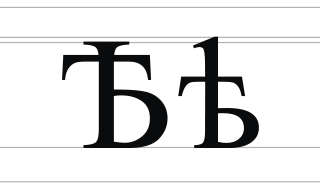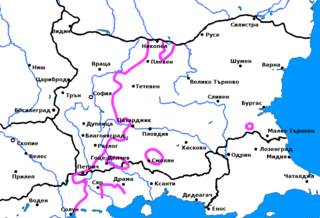
Macedonian is an Eastern South Slavic language. It is part of the Indo-European language family, and is one of the Slavic languages, which are part of a larger Balto-Slavic branch. Spoken as a first language by around two million people, it serves as the official language of North Macedonia. Most speakers can be found in the country and its diaspora, with a smaller number of speakers throughout the transnational region of Macedonia. Macedonian is also a recognized minority language in parts of Albania, Bosnia and Herzegovina, Romania, and Serbia and it is spoken by emigrant communities predominantly in Australia, Canada and the United States.

The Slavic languages, also known as the Slavonic languages, are Indo-European languages spoken primarily by the Slavic peoples or their descendants. They are thought to descend from a proto-language called Proto-Slavic, spoken during the Early Middle Ages, which in turn is thought to have descended from the earlier Proto-Balto-Slavic language, linking the Slavic languages to the Baltic languages in a Balto-Slavic group within the Indo-European family.

Yat or Jat is the thirty-second letter of the old Cyrillic alphabet.
The history of the Slavic languages stretches over 3000 years, from the point at which the ancestral Proto-Balto-Slavic language broke up into the modern-day Slavic languages which are today natively spoken in Eastern, Central and Southeastern Europe as well as parts of North Asia and Central Asia.

The Northwestern Bulgarian dialects are two closely related dialects of the Bulgarian language, which are located west of the yat boundary and thus are part of the Western Bulgarian dialects. The range of the dialects includes most of northwestern Bulgaria, to the west of the line between Nikopol, Pleven and Mezdra and to the north of the line between Vratsa and Belogradchik. They bear strong resemblance to their neighbouring Eastern Bulgarian dialects and with some exceptions, mainly the pronunciation of yat, have the same phonological and morphological features as the neighbouring subdialects of the Eastern Bulgarian Central Balkan dialect.

The Byala Slatina-Pleven dialect is a Bulgarian dialect spoken in the regions of Pleven, Byala Slatina and Kula in northwestern Bulgaria. The dialect is part of the Northwestern Bulgarian dialects. The most significant feature of the dialect, as in all Western Bulgarian dialects, is the pronunciation of Old Church Slavonic ѣ (yat) only as instead of formal and Eastern Bulgarian я/е (~) – бел/бели instead of бял/бели. Otherwise, the Byala Slatina-Pleven dialect bears strong resemblance to its neighbouring Eastern Bulgarian dialects and with some exceptions, mainly the pronunciation of yat, has the same phonological and morphological features as the neighbouring subdialects of the Eastern Bulgarian Central Balkan dialect.

The Balkan dialects are the most extensive group of dialects of the Bulgarian language, covering almost half of the present-day territory of Bulgaria and slightly less than a third of the territory on the Balkans where Bulgarian is spoken. Their range includes north-central Bulgaria and most of the Bulgarian part of Thrace, excluding the Rhodopes, the region of Haskovo and Strandzha. As a result of the mass population movements that affected eastern Bulgaria during the 19th and the beginning of the 20th century, the Balkan dialects are now spoken also in vast areas of northeastern Bulgaria, especially the regions of Dobrich and Varna. The most significant feature of the dialects, as in most Eastern Bulgarian dialects, is the pronunciation of Old Church Slavonic ѣ (yat) as or, depending on the character of the following syllable. The Balkan dialects, and in particular, the Central Balkan dialect, lie at the foundation of formal Bulgarian. However, they are not identical to the standard language because many of its features derive from the Western Bulgarian dialects, including the Macedonian dialects, or are a compromise between Eastern and Western standard.

The Central Balkan dialect is a Bulgarian dialect that is part of the Balkan group of the Eastern Bulgarian dialects. Its range includes most of north-central Bulgaria, as well as the regions of Karlovo, Kazanlak and Plovdiv in southern Bulgaria, all the way down to the northernmost ridges of the Rhodopes. As a result of the mass population movements that affected eastern Bulgaria during the 19th and the beginning of the 20th century, the Central Balkan dialect is now spoken also in vast areas of northeastern Bulgaria. The most significant feature of the dialect is the pronunciation of Old Church Slavonic ѣ (yat) as or, depending on the character of the following syllable. The Central Balkan dialect lies at the foundation of formal Bulgarian. However, it is not identical to the standard language because many of its features derive from the Western Bulgarian dialects, including the Macedonian dialects, or are a compromise between Eastern and Western standard. The Central Balkan dialect includes a number of subdialects, e.g. Troyan, Lovech, Gabrovo, Karlovo, Kalofer, Tryavna, etc. which share many common features and yet have some differences.
The Kotel-Elena-Dryanovo dialect is a Bulgarian dialect, which is part of the Balkan group of the Eastern Bulgarian dialects. Its range includes the eastern parts of the Balkan Mountains, i.e. the regions of Dryanovo, Kotel and Elena). As a result of the mass population movements that affected eastern Bulgaria during the 19th and the beginning of the 20th century, speakers of the dialect have also moved south towards Burgas and north towards Varna and Targovishte. The most significant feature of the dialect, as in all Balkan dialects, is the pronunciation of Old Church Slavonic ѣ (yat) as or, depending on the character of the following syllable. The Kotel-Elena-Dryanovo dialect can be divided into three subdialects, i.e. Kotel, Elena and Dryanovo etc. which share many common features and yet have some differences.

The Subbalkan dialect is a Bulgarian dialect, which is part of the Balkan group of the Eastern Bulgarian dialects. Its range includes the northeastern part of Bulgarian Thrace, i.e. the regions of Burgas, Sliven, Yambol, Stara Zagora and Chirpan. As a result of the mass population movements that affected eastern Bulgaria during the 19th and the beginning of the 20th century, speakers of the Subbalkan dialect have moved en masse to northeastern Bulgaria and now form a vast portion of the population of the districts of Varna, Dobrich and Balchik. Some of these also went as far as Bessarabia establishing numerous colonies there. Nowadays, a large part of the Bessarabian Bulgarians speak this dialect. The most significant feature of the Subbalkan dialect, as in all Balkan dialects, is the pronunciation of Old Church Slavonic ѣ (yat) as or, depending on the character of the following syllable.
The Pirdop dialect is a Bulgarian dialect, which is part of the Balkan group of the Eastern Bulgarian dialects. Its range includes the towns of Pirdop, Zlatitsa and Koprivshtitsa, as well as several neighbouring villages. The most significant feature of the dialect, as in all Balkan dialects, is the pronunciation of Old Church Slavonic ѣ (yat) as or, depending on the character of the following syllable. However, the Pirdop dialect also features a number of characteristics which bring it closer to the neighbouring Western Bulgarian dialects, and especially to the Botevgrad dialect and which, in turn, separate it from the rest of the Balkan dialects.
The Panagyurishte dialect is a Bulgarian dialect, which is part of the Balkan group of the Eastern Bulgarian dialects. Its range includes the town of Panagyurishte, as well as a number of neighbouring villages. The most significant feature of the dialect, as in all Balkan dialects, is the pronunciation of Old Church Slavonic ѣ (yat) as or, depending on the character of the following syllable.

The Rup dialects, or the Southeastern dialects, are a group of Bulgarian dialects located east of the yat boundary, thus being part of the Eastern Bulgarian dialects. The range of the Rup dialects includes the southern part of Thrace, i.e. Strandzha, the region of Haskovo, the Rhodopes and the eastern half of Pirin Macedonia.
The Smolyan dialect or Central Rhodope dialect is a Bulgarian dialect of the Rhodopean group of the Rup dialects. Its range includes most of the Central Rhodopes, i.e. the region of Smolyan. Its immediate neighbours are the Rhodopean Hvoyna dialect to the north, the Serres-Nevrokop dialect and the Razlog dialect to the west and the Turkish dialects of the Turkish population in the Eastern Rhodopes. To the south, the Smolyan dialect crosses the Greek-Bulgarian border and is spoken by much of the Muslim Bulgarian (Pomak) population in Western Thrace. As a result of the rugged mountainous terrain and the century-long isolation of the region from the rest of the country, the Smolyan dialect is the most idiosyncratic of all Bulgarian dialects and is not readily understandable even for its immediate neighbours.
The Chepino dialect is a Bulgarian dialect of the Rhodopean group of the Rup dialects. Its range includes the northwestern Rhodopes, i.e. the towns of Velingrad, Rakitovo and Kostandovo and the villages of Dragichevo and Dorkovo. Its immediate neighbours are the Central Balkan dialect and the Ihtiman dialect to the north, the Babyak dialect to the west and south and the Hvoyna dialect to the east. The Chepino dialect is spoken by both Orthodox and Muslim Bulgarians in the region irrespective of religious affiliation.
The Paulician dialect is a Bulgarian dialect of the Rhodopean group of the Rup dialects. The Paulician dialect is spoken by some 40,000 people, nearly all of them Catholic Bulgarians, in the region of Rakovski in southern Bulgaria and Svishtov in northern Bulgaria, aswell as regions in Romania. The language of the Banat Bulgarians, late 17th century Bulgarian Catholic migrants to Banat, is phonologically and morphologically identical to the Paulician dialect.
The Zlatograd dialect is a Bulgarian dialect, member of the Rup or Southeastern Bulgarian dialects. The Zlatograd dialect is spoken in the southwestern part of the Eastern Rhodopes, i.e. in the town of Zlatograd, as well as a number of neighbouring villages and towns, e.g. Nedelino, Kirkovo, etc. The Zlatograd dialect is most closely related to the eastern and western Rup dialects, but also shares a number of phonological and morphological characteristics with the Rhodopean dialects. Thus, it is usually considered to be transitional between the two groups.
The Babyak dialect is a Bulgarian dialect, member of the Rup or Southeastern Bulgarian dialects. It is spoken in several mountainous villages on the western fringes of the Rhodopes and is thus sandwiched between the Chepino dialect on the east and northeast and the Razlog dialect to the south and west. It shares a number of phonological characteristics with both the Rup and the Southwestern dialects. Because of its specific reflexes of Old Church Slavonic yat, it is generally classified as a Rup dialect but is actually transitional between the two dialectal groups.
The Teteven dialect is a Bulgarian dialect, which is part of the Balkan group of the Eastern Bulgarian dialects. It is spoken in the town of Teteven and several neighbouring villages and is almost completely surrounded by the Central Balkan dialect, except on the west where it borders on the Western Bulgarian Botevgrad dialect. The most significant feature of the dialect, as in all Balkan dialects, is the pronunciation of Old Church Slavonic ѣ (yat) as or, depending on the character of the following syllable.
The Shumen dialect is a Bulgarian dialect, member of the Moesian dialects. It is one of the best preserved Moesian dialects and is spoken in the regions of Shumen and Kaspichan.




